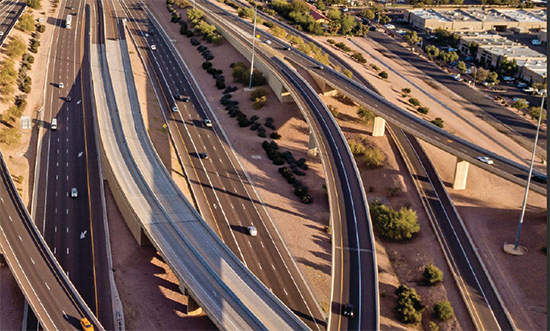
The Arizona Department of Transportation’s (ADOT) first public-private partnership (P3) selected asphalt to deliver a new 22-mile freeway (Loop 202) three years early with over $100 million in savings.
As early as 1985 these 22 miles of freeway were part of the regional plans to connect the West Valley and East Valley around the south side of Phoenix. In the following 20 years, the population growth of the Phoenix metropolitan region required planning for an 8-lane freeway with 50 overpasses and 13 interchanges.
In the end, it evolved into the largest highway construction project in Arizona. To expedite the project, ADOT engaged the nationally successful P3 approach for its first design, construct and maintain (DC&M) contract.
P3 approach
To facilitate such public-private partnerships for future developments of the state’s transportation infrastructure, the legislature enacted Arizona revised statutes, Title 28, Chapter 22, Article 1. As usual with large engineering projects, a request for qualifications (RFQ) was issued in October 2014, followed by a request for proposal (RFP) after shortlisting three qualifying proposers. In December 2015 the state started negotiations with the selected proposer and signed the contract in February 2016.
There are separate provisions and prices for the design and construct (D&C) part and the 30-year maintain (M) part of the contract. The three “Connect 202 Partners” (the developer) were Fluor Enterprises, Granite Construction and Ames Construction with several project advisors and consultants.The designer was Parsons Brinkerhoff and Transtec was responsible for geotechnical and pavement engineering.
Funding for the $1.82 billion project came from FHWA ($493 million), Arizona Highway User Revenue Fund ($206 million) and the Regional Area Road Fund ($1.14 billion from sales tax and bonds).
The developer is responsible for the safe maintenance of the freeway for 30 years after completion. The design, construct and maintain contract approach safeguards the state from project delays, cost overruns and results in the most economical designs and pavement type selection.
Getting to work
To expedite completion of the freeway, the project was split into four segments instead of the original plan for nine segments. From the connection with I-10 on the west side of Phoenix to the connection with I-10 near Chandler on the southeast side of the city, segments were named the Papago, Salt River, Center and Pecos Road segments.
The Papago segment included significant work on the existing I-10 with more than 200,000 vehicles passing through daily. The Salt River segment features two 2,700 ft. bridges to cross the river and seven miles of freeway. The Center segment required a significant amount of rock blasting for the alignment to skirt the South Mountains. The nine-mile Pecos segment runs through an area where Frank Lloyd Wright-designed a desert resort. ADOT and the project team applied Frank Lloyd Wright-styled motifs in the aesthetics of bridges and sound walls in this segment. The four distinct segments allowed for the separate management needed because of the differences in geology and in construction features in each area.
Pavement design was provided by Transtec out of Austin, Texas. They also provided LCCA and maintenance planning. In the end, asphalt was selected over concrete partly because of these advantages:
• Durable and adaptable
• Expedites construction
• Extended pavement life with SBS (Styrene-Butadiene-Styrene) -modified binder (PG 76-22)
In pavement structural design, the subgrade strength plays an important role. The Salt River segment had a lower subgrade strength than the other segments. To accommodate for the lower subgrade strength additional thickness of the aggregate base (AB) was needed. Throughout the 22-mile project, a total of 1.45 million tons of aggregate base was used.
The structural pavement thickness design for the mainline was:
• AR-ACFC wearing surface – ½” thickness
• Several AC (asphalt concrete) lifts totaling between 4 to 6” each
• Aggregate Base (Class 2 AB) of varying depth of 8 to 12”
The asphalt base layer with PG 70-10 binder was produced with 15 percent RAP. The selection of SBS modification of the PG 76-22 (SBS) binder was based on the Asphalt Institute’s report IS-215, which was based on 155 test sections in North America and concluded that an 80 percent longer pavement life can be expected when using polymer modified instead of neat binders.
The asphalt paving partner, Granite Construction, engaged five Vulcan Materials plants located in proximity to the project to supply the mixes. Four plants were used with the fifth as a back-up. Once the roadbed was prepared and the mix designs approved, the mainline paving started in 2018.
Maintenance
The maintenance contract requires the developer to remain responsible for the safe upkeep of the freeway for a period of 30 years. The LCCA of the maintenance contract requires that the AR-ACFC layer to be replaced at years 10 and 30 and a 2-1/2” mill-and-replace plus AR-ACFC layer at year 20 and at the end of year 30 with a remaining pavement life of 10 years.
The project is already open to traffic, while the final AR-ACFC wearing surface was scheduled to be placed in the spring of 2020 as soon as the temperatures allowed for good quality placement.
The design, construct and maintain contracts spelled out in great detail the responsibilities of the project partners and the results to be expected. As a first for Arizona DOT, the P3 has proven to be beneficial in expediting project delivery by three years and saving more than $100 million compared to what was originally budgeted.
Based on the performance advantages and economics, asphalt was selected as the preferred pavement type and a total of 1.33 million tons of asphalt was placed.
Humer is an Asphalt Institute Senior Regional Engineer based in California













